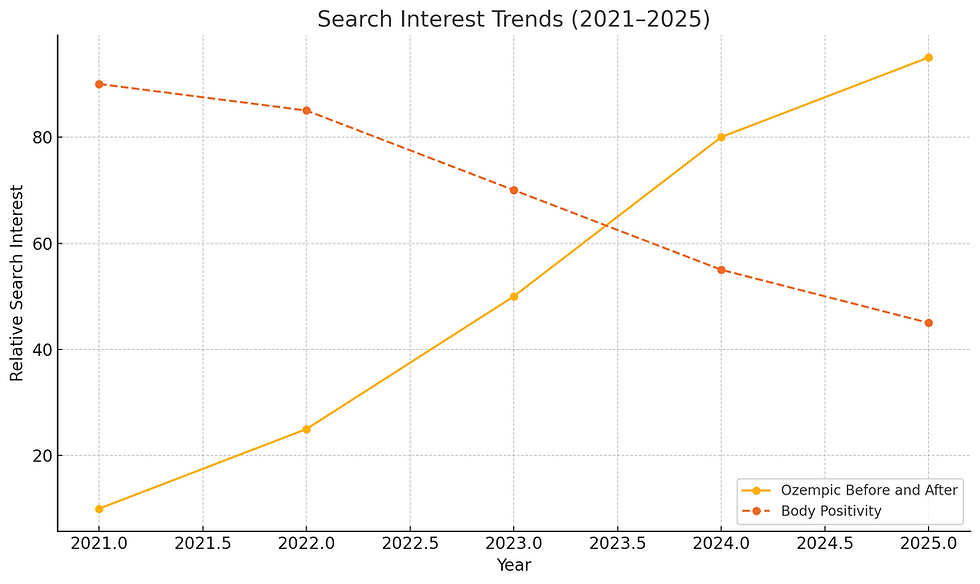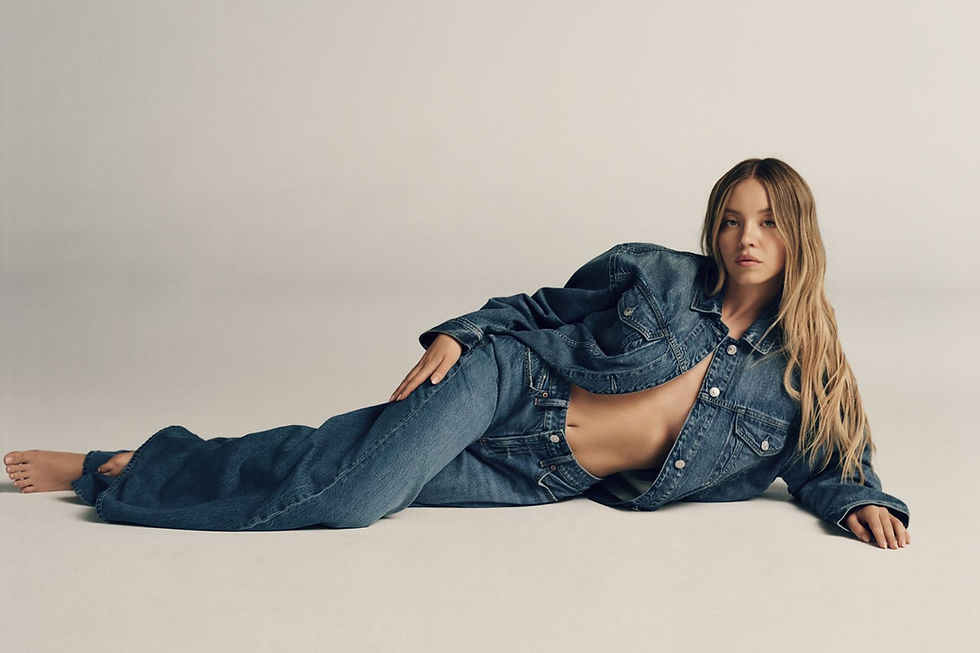Ozempic Made Thin Cool Again and Fashion Followed
- Team picks

- Aug 4
- 3 min read
How GLP-1 Drugs Like Ozempic Are Quietly Rewriting Fashion and Body Image Norms.

In 2016, brands like Aerie, Dove, and Chromat basked in praise for promoting real bodies and inclusive sizing. The body positivity movement gained corporate traction, a newfound social currency, and for a moment, it seemed like the "thin ideal" was finally losing its cultural stronghold.
Then came Ozempic.
The rise of GLP-1 receptor agonists like Ozempic, Wegovy, and Mounjaro, originally intended to treat type 2 diabetes and obesity, is now inextricably linked with the reemergence of thinness as an aspirational aesthetic. While #OzempicBody trends on TikTok and influencers share suspiciously rapid “wellness journeys,” fashion houses and casting directors are quietly adjusting their standards. Again.
A Familiar Shape Resurfaces
Sydney Sweeney—now a Gen-Z icon—was recently featured in a much-criticized campaign for American Eagle, wearing ultra-low-rise jeans reminiscent of the early 2000s. While Sweeney herself hasn’t confirmed any use of GLP-1s, critics online were quick to call the campaign a betrayal of body inclusivity. The reaction sparked headlines in outlets like Teen Vogue and The Cut, reigniting the debate around who gets to be considered fashionable.
According to the New York Times, the global weight loss drug market is expected to reach $100 billion by 2030, with over 15 million prescriptions already written in the U.S. by 2024 alone. These figures aren’t just a healthcare story—they are a fashion story, a marketing story, and a cultural reckoning.
From Inclusivity to Aspiration
Brands that once marketed plus-size offerings are quietly scaling back. Old Navy reversed its widely publicized size-inclusive initiative in 2022, citing inventory issues. Around the same time, Victoria’s Secret phased out some of its body diversity efforts, signaling a return to its original marketing model.
A recent JSTOR study on media and body image found that between 2022 and 2024, mentions of “body positivity” declined by 42% across digital publications, while search terms related to “Ozempic before and after” and “fast weight loss” surged. Google Trends confirms that queries for “how to get skinny fast” saw a 136% increase in 2024, aligning with the mainstreaming of GLP-1 drugs.
“Thinness is back,” writes Vox journalist Rebecca Jennings, “and this time it’s dressed as self-care.”

Hollywood, Instagram, and the Illusion of “Effortless”
The cultural pivot isn’t just in fashion. Celebrities like Kim Kardashian, Elon Musk, and Chelsea Handler have either openly discussed or been suspected of using Ozempic or similar drugs. Social media is awash in sanitized transformation posts—toned abs, cinched waists, and glowing skin—without mention of syringes or side effects.
This glossing over of pharmacological assistance creates a distorted view of health and beauty. “People aren’t just getting thinner,” says Dr. Fatima Stanford, an obesity medicine physician at Harvard Medical School. “They’re getting thinner faster—and that changes public perception of what's achievable naturally.”

The Industry Response
Retailers and designers are recalibrating—again. According to BoF, designers are fitting samples two sizes smaller than they did in 2020. A recent Lyst report showed a 58% uptick in searches for “low-rise jeans” and “slim-fit tops” in Q1 of 2025.
Meanwhile, the #BodyNeutrality movement is gaining traction, pushing for self-acceptance without aesthetic glorification. But its reach is limited. “Ozempic culture has made thinness appear not just desirable, but inevitable,” says Virgie Tovar, a body image expert and author of You Have the Right to Remain Fat.
Final Thoughts
The fashion industry does not operate in a vacuum. Whether via insulin mimetics or Instagram aesthetics, consumer trends are always dictated by larger cultural forces. The return of the “skinny look” isn’t spontaneous—it’s systemically manufactured, medically engineered, and algorithmically promoted.
To quote Susan Bordo, cultural theorist and author of Unbearable Weight:
“The body is a medium of culture. And it is never neutral.”
Medical Disclaimer
The information provided in this article is for educational and informational purposes only and is not intended as medical advice. It should not be used to diagnose, treat, cure, or prevent any medical or mental health condition. Always seek the guidance of a qualified healthcare professional or licensed mental health provider with any questions you may have regarding a medical condition, diagnosis, or treatment. Never disregard professional medical advice or delay seeking it because of something you have read here.



Comments